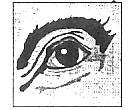 TRIZ
Textbooks: CID Course for Children, 1-1G4 TRIZ
Textbooks: CID Course for Children, 1-1G4 |
  
|
Topic 4.
How to find out?
(Organs of Perception) |
Fairy Tales
School:
Course of Creative Imagination
Development (CID), 1st Grade, 1st Semester, Methodical Guide-Book |
Natalia
V. Rubina, 1999 [published
in Russian]
English
translation by Irina Dolina,
May 23, 2000
Technical
Editing by Toru Nakagawa, Feb.
28, 2001 |
Posted
in this "TRIZ Home Page in Japan" in English on Feb. 28, 2001 under the
permission of the Author.
(C) N.V. Rubina,
I. Dolina, and T. Nakagawa 2001 |
 |
Topic 4.
How to find out ?
(Organs of Perception) |
Workbook
Lesson 1.
1. Warming up
(Card-index for the first grade)
2. Homework check-up
3. Introduction in the lesson

Emil and Losharic
went on a trip. The day was sunny and quiet. The friends walked
cheerfully along the path in the forest.
- Let's play 'Hide and seek',- suggested
Losharic,- I'll hide!
- Don't run away far and don't climb
the trees!
The game was very
funny, because the forest is a good place for hiding. No wonder that
the friends didn't notice how the time passed. It was time to go
home. But the problem is that neither Emil nor Losharic can remember
where to go. The forest around them was deep, unfamiliar. They
lost their way.
How to help the friends?
4. Main topic

Solve the riddle and you
will find out who can help to solve this problem.
Olya is looking at the cat.
At the pictures of the tale.
And for that Olya needs ....
(eyes) |
There is a pasty before Olya.
It has a fried side.
Take a bite at a pasty...
tasty? - will say...
(tongue) |
Olya is listening in the forest
how the cuckoos cries.
And for that Olya needs ...
(ears) |
Mother in the kitchen
is preparing a tray.
What is on the tray will tell us...
(nose) |
Olya touches the snow -
It is cold to touch.
And for that Olya needs.......
(fingers) |
|
[Translation Note (Feb.
28, 2001): This riddle is based on guessing the proper
human organs of perception. The children are expected to find an
organ of perception that is rhymed to a key word. E.g. 'skaski' -
'glaski' (tales - eyes), 'bochok' - 'yazychok' (side-tongue), 'kukushki'
- 'ushki' (cockoos - ears), 'podnos' - 'nos' (tray - nose).
As you can see, those words are not rhymes in English.]
- Thus, here
they are our assistants: eyes to see; ears to hear; a tongue to taste;
a nose to smell; hands to touch. Eye sight, hearing, taste, sense
of touch help a human being to learn everything about the world around.
The peculiarities of
your kids perception will prompt how to organize further work. In
the Card Index for the First Grade there are detailed information about
all the organs of the human senses. If the kids perceive such information
with interest, you can, using illustrative stuff, introduce the kids
to the construction of an eye. They know a person hears, what
is the sense of smell, sense of touch, how the taste forms. But if
the kids have difficulties in listening for a long time, you may make a
game out of a study. In the Card Index for the First Grade
you will find games that will widen your idea of human organs of senses
.
5. Psychotechnical and developing games
(Card Index for the First Grade)
7. Summing up
Draw the kids'
attention to the amazing resources of a human, human being. Comparing
the organs of senses of a person and of the animals, one can draw
a conclusion that a person lost many of animal resources he had before
becoming more independent of Nature (e.g., animal night eye sight, hearing
of many predators, a sense of smell and other peculiarities of perception).
However, the human intellect let him widen his resources beyond limits.
[Translation Note: Lesson 2 of
this Topic is missing in the text. The Author's response to the Editor:
Topics 4 to 6 are given in a little abbreviated variant. They are
complemented by plays and problems in exhibit. I can send this exhibit
on E-mail if it is necessary. (Feb. 28, 2001)]
Last updated
on Feb. 28, 2001. Access point: Editor: nakagawa@utc.osaka-gu.ac.jp


